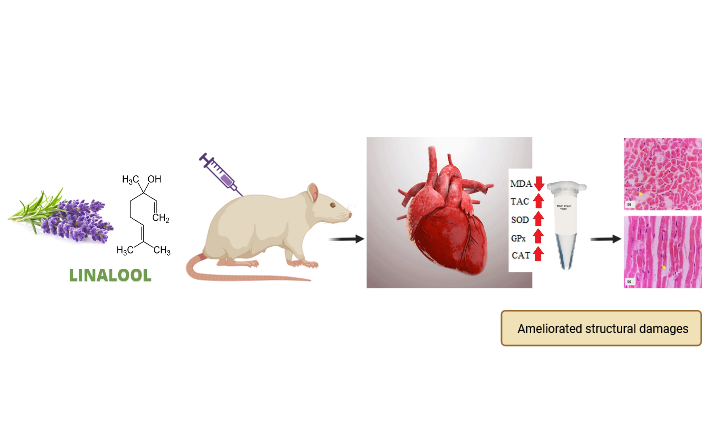Volume 35, Issue 246 (7-2025)
J Mazandaran Univ Med Sci 2025, 35(246): 1-11 |
Back to browse issues page
Download citation:
BibTeX | RIS | EndNote | Medlars | ProCite | Reference Manager | RefWorks
Send citation to:



BibTeX | RIS | EndNote | Medlars | ProCite | Reference Manager | RefWorks
Send citation to:
Taraghy G, Rahimi S, Ojarudi M, Fazaeli A, Namjoo Z, Rezagholizadeh L. Investigation of the Effect of Linalool on Carbon TetrachlorideInduced Oxidative Myocardial Injury in Male Rats. J Mazandaran Univ Med Sci 2025; 35 (246) :1-11
URL: http://jmums.mazums.ac.ir/article-1-21902-en.html
URL: http://jmums.mazums.ac.ir/article-1-21902-en.html
Ghasem Taraghy 
 , Shiva Rahimi
, Shiva Rahimi 
 , Masoud Ojarudi
, Masoud Ojarudi 
 , Aliakbar Fazaeli
, Aliakbar Fazaeli 
 , Zeinab Namjoo
, Zeinab Namjoo 
 , Lotfollah Rezagholizadeh
, Lotfollah Rezagholizadeh 


 , Shiva Rahimi
, Shiva Rahimi 
 , Masoud Ojarudi
, Masoud Ojarudi 
 , Aliakbar Fazaeli
, Aliakbar Fazaeli 
 , Zeinab Namjoo
, Zeinab Namjoo 
 , Lotfollah Rezagholizadeh
, Lotfollah Rezagholizadeh 

Abstract: (426 Views)
Background and purpose: Cardiovascular diseases are among the leading causes of mortality worldwide, with myocardial injury often resulting from oxidative stress, drugs, and toxins. Linalool, a natural monoterpene alcohol found in various medicinal plants, has been reported to modulate oxidative stress. This study aimed to investigate the protective effects of linalool against oxidative myocardial damage induced by carbon tetrachloride (CCl ) in rats.
) in rats.
Materials and methods: In this experimental study, 24 male Wistar rats were randomly divided into four groups of six (normal control, linalool control, injury group, and linalool pretreatment group). The first two groups received either physiological saline or linalool (25 mg/kg) for 14 days. The injury group was administered physiological saline for 14 days, followed by a single dose of 1 ml/kg of a 1:1 (v/v) olive oil and CCl mixture on the 14th day. The fourth group received linalool (25 mg/kg) for 14 days, followed by the same CCl
mixture on the 14th day. The fourth group received linalool (25 mg/kg) for 14 days, followed by the same CCl mixture on day 14. Forty-eight hours after CCl
mixture on day 14. Forty-eight hours after CCl administration, animals were anesthetized, and cardiac tissues were collected for biochemical and histopathological analyses.
administration, animals were anesthetized, and cardiac tissues were collected for biochemical and histopathological analyses.
Results: The results showed that CCl significantly decreased the activity of antioxidant enzymes and total antioxidant capacity (P< 0.001), and increased malondialdehyde (MDA) levels compared to the control group (P< 0.001). Pretreatment with linalool significantly increased the antioxidant indices (P<0.001) and reduced MDA levels relative to the injury group (P<0.001). Furthermore, histopathological examination showed that linalool pretreatment mitigated CCl
significantly decreased the activity of antioxidant enzymes and total antioxidant capacity (P< 0.001), and increased malondialdehyde (MDA) levels compared to the control group (P< 0.001). Pretreatment with linalool significantly increased the antioxidant indices (P<0.001) and reduced MDA levels relative to the injury group (P<0.001). Furthermore, histopathological examination showed that linalool pretreatment mitigated CCl -induced structural alterations in myocardial tissue.
-induced structural alterations in myocardial tissue.
Conclusion: Linalool effectively protects against CCl -induced myocardial oxidative damage by reducing lipid peroxidation, enhancing antioxidant capacity, and preserving cardiac tissue structure.
-induced myocardial oxidative damage by reducing lipid peroxidation, enhancing antioxidant capacity, and preserving cardiac tissue structure.
 ) in rats.
) in rats. Materials and methods: In this experimental study, 24 male Wistar rats were randomly divided into four groups of six (normal control, linalool control, injury group, and linalool pretreatment group). The first two groups received either physiological saline or linalool (25 mg/kg) for 14 days. The injury group was administered physiological saline for 14 days, followed by a single dose of 1 ml/kg of a 1:1 (v/v) olive oil and CCl
 mixture on the 14th day. The fourth group received linalool (25 mg/kg) for 14 days, followed by the same CCl
mixture on the 14th day. The fourth group received linalool (25 mg/kg) for 14 days, followed by the same CCl mixture on day 14. Forty-eight hours after CCl
mixture on day 14. Forty-eight hours after CCl administration, animals were anesthetized, and cardiac tissues were collected for biochemical and histopathological analyses.
administration, animals were anesthetized, and cardiac tissues were collected for biochemical and histopathological analyses. Results: The results showed that CCl
 significantly decreased the activity of antioxidant enzymes and total antioxidant capacity (P< 0.001), and increased malondialdehyde (MDA) levels compared to the control group (P< 0.001). Pretreatment with linalool significantly increased the antioxidant indices (P<0.001) and reduced MDA levels relative to the injury group (P<0.001). Furthermore, histopathological examination showed that linalool pretreatment mitigated CCl
significantly decreased the activity of antioxidant enzymes and total antioxidant capacity (P< 0.001), and increased malondialdehyde (MDA) levels compared to the control group (P< 0.001). Pretreatment with linalool significantly increased the antioxidant indices (P<0.001) and reduced MDA levels relative to the injury group (P<0.001). Furthermore, histopathological examination showed that linalool pretreatment mitigated CCl -induced structural alterations in myocardial tissue.
-induced structural alterations in myocardial tissue. Conclusion: Linalool effectively protects against CCl
 -induced myocardial oxidative damage by reducing lipid peroxidation, enhancing antioxidant capacity, and preserving cardiac tissue structure.
-induced myocardial oxidative damage by reducing lipid peroxidation, enhancing antioxidant capacity, and preserving cardiac tissue structure.
Type of Study: Research(Original) |
Subject:
Sports biomechanics
Send email to the article author
| Rights and permissions | |
 |
This work is licensed under a Creative Commons Attribution-NonCommercial 4.0 International License. |





